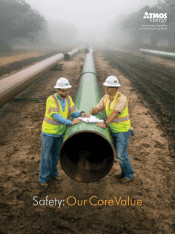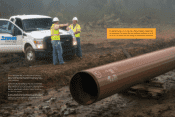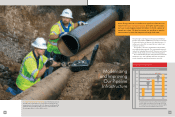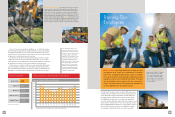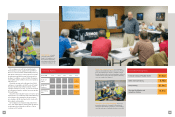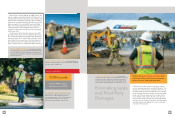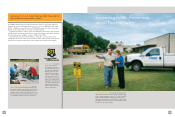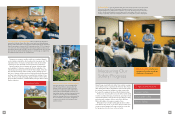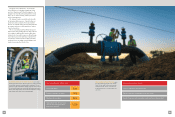Atmos Energy 2015 Annual Report Download - page 4
Download and view the complete annual report
Please find page 4 of the 2015 Atmos Energy annual report below. You can navigate through the pages in the report by either clicking on the pages listed below, or by using the keyword search tool below to find specific information within the annual report.
4
To assist in assessing a pipeline’s condition, we use field instrumenta-
tion and engineering analysis to identify anomalies, cracks, deterioration
or corrosion that might occur. We also conduct hydrostatic testing when
needed to ensure that a pipeline can operate in excess of its normal oper-
ating pressure and during peak-service periods.
The obvious benefit of our modernization program is safer and more
reliable service for our customers and the communities we serve. Fortu-
nately, we have received approvals for very balanced regulatory mechanisms
to support the necessary investments to make these improvements.
Furthermore, our customers’ bills have remained relatively flat despite
our modernization expenditures. The abundance and low cost of natural
gas in the United States today is keeping our average residential bills very
affordable—a situation that we anticipate will remain for years to come.
Atmos Energy Annualized Monthly Residential Bills
Average Customer Bill Remains Affordable
Estimated bills for fiscal 2016 through fiscal 2020 are based on normal weather.
$70
$60
$50
$40
$30
$20
$10
$0
07 08 09 10 11 12 13 14 15 16E 17E 18E 19E 20E
$58
$52
$58
In Marrero, Louisiana, the main natural gas artery serving our
customers on the west bank of the Mississippi River in the Greater New
Orleans Region is being replaced by our Louisiana Division. The pipeline,
installed some 70 to 80 years ago, is one of our many modernization
projects across the state. The division expects to replace over many years
a significant portion of its distribution mains as well as aging meters, risers,
regulator stations and town border stations. Below: A collection of sensitive
instruments, called a “smart pig,” is sent through a pipeline to detect cracks,
corrosion, dents or deterioration that might cause a failure. We regularly
inspect our pipelines as part of our pipeline integrity management programs.
Our natural gas customers are
seeing virtually no effect on their
bills from our investing in pipeline
infrastructure. Since fiscal 2007, our
average monthly residential bills,
adjusted for seasonality, have been
below $62. We expect our bills to
remain affordable through fiscal
2020 because of the country’s abun-
dant supplies of low-cost natural
gas. In fiscal 2015, our average
monthly residential bill of $52 was
the lowest among all household
utility bills, based on comparable
regional or national data.
5
Monthly Utility Bills
See data sources on page 36.
Natural Gas $52
Cable TV $77
Electricity $12 8
Water & Sewer $13 7
Mobile Phone $13 8
Our Charles K. Vaughan Center marked its fifth anniversary
in 2015 as the gas industry’s best-in-class training facility. The
center offers fully equipped classrooms and labs along with
two highly advanced facilities for hands-on learning. Inside
the 48,600-square-foot center is the Flow Lab, containing
every type of gas regulation, control and metering device used
on our system. Outside on the 11-acre site is Gas City, a simu-
lated neighborhood with apartments, single-residence houses,
commercial buildings and city streets. Its flexibility reinforces
our employees’ training for all types of real-life scenarios.
On the surface, natural gas distribution and transmission
may appear to be simple, but underground it’s another
story. There, complicated technologies, nearly $7.5 billion
of net assets and thousands of pages of federal and state
regulations and our own standards all interact. To render
safe and reliable service requires that our service tech-
nicians and construction and maintenance operators be
not only dedicated, but also highly trained.
Since opening in 2010,
Atmos Energy’s Charles K. Vaughan
Center has conducted more than
37,000 hours of training for nearly
3,800 employees, who have taken
about 400 classes. The center offers
some 15 standard courses and is in
use nearly full time.
Training Our
Employees

